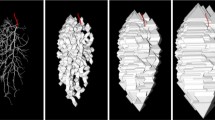Abstract
A combination of experimental, theoretical, and imaging methodologies is used to examine the hierarchical structure and function of intramyocardial arteriolar trees in porcine hearts to provide a window onto a region of myocardial microvasculature which has been difficult to fully explore so far. A total of 66 microvascular trees from 6 isolated myocardial specimens were analyzed, with a cumulative number of 2438 arteriolar branches greater than or equal to 40 μm lumen diameter. The distribution of flow rates within each tree was derived from an assumed power law relationship for that tree between the diameter of vessel segments and flow rates that are consistent with that power law and subject to conservation of mass along hierarchical structure of the tree. The results indicate that the power law index increases at levels of arteriolar vasculature closer to the capillary level, consistent with a concomitant decrease in shear stress acting on endothelial tissue. These results resolve a long standing predicament which could not be resolved previously because of lack of data about the 3D, interconnected, arterioles. In the context of myocardial perfusion, the results indicate that the coefficient of variation of flow rate in pre-capillary distal arterioles is high, suggesting that heterogeneity of flow rate in these arterioles is not entirely random but may be due at least in part to active control.








Similar content being viewed by others
References
Austin, R. E. Jr., G. S. Aldea, D. L. Coggins, A. E. Flynn, and J. I. E. Hoffman. Profound spatial heterogeneity of coronary reserve. Circ. Res. 67:319–331, 1990.
Bassingthwaighte, J. B., J. H. G. M. Van Beek, and R. B. King. Fractal branchings: the basis of myocardial flow heterogeneities. Ann. N.Y Acad. Sci. 591:392–401, 1990.
Feldkamp, L. A., L. C. David, and J. W. Kress. Practical cone-beam algorithm. J. Optical Soc. Am. A: Optics Image Sci. Vision 1:612–619, 1984.
Ho, Y., B. Kaimovitz, Y. Lanir, T. Wischgool, J. I. E. Hoffman, and G. S. Kassab. Biophysical model of the spatial heterogeneity of myocardial flow. Biophys. J. 96:4035–4043, 2009.
Hutchins, G. M., M. M. Miner, and J. K. Boitnott. Vessel caliber and branch-angle of human coronary artery branch-points. Circ. Res. 38:572–576, 1976.
Huveneers, S., M. J. Daemen, and P. L. Hordijk. Between Rho(k) and a hard place: the relation between vessel wall stiffness, endothelial contractility, and cardiovascular disease. Circ. Res. 116(5):895–908, 2015.
Jorgensen, S. M., O. Demirkaya, and E. L. Ritman. Three-dimensional imaging of vasculature and parenchyma in intact rodent organs with x-ray micro-CT. Am. J. Physiol. 275(Heart Circ Physiol) 44:H1103–H1114, 1998.
Kaimovitz, B., Y. Huo, Y. Lanir, and G. S. Kassab. Diameter asymmetry of porcine coronary arterial tree: structural and functional implications. Am. J. Physiol. Heart Circ. Physiol. 294:H714–H723, 2008.
Kline, T. L., M. Zamir, and E. L. Ritman. Accuracy of microvascular measurements obtained from micro-CT images. Ann. Biomed. Eng. 38:2851–2864, 2010.
Kline, T. L., M. Zamir, and E. L. Ritman. Relating function to branching geometry: a micro-CT study of the hepatic artery, portal vein, and biliary tree. Cells Tissues Organs 195:431–442, 2011.
Malyar, N. M., M. Goessl, P. E. Beighley, and E. L. Ritman. Relationship between arterial diameter and perfused tissue volume in myocardial microcirculation—a micro-CT based analysis. Am. J. Physiol: Heart Circ. Physiol. 286:H2386–H2392, 2004.
Marxen, M., J. G. Sled, L. X. Yu, C. Paget, and R. M. Henkelman. Comparing microsphere deposition and flow modeling in 3D vascular trees. Am. J. Physiol. Heart Circ. Physiol. 291:H2136–H2141, 2006.
Mayrovitz, H. N., and J. Roy. Microvascular blood flow evidence indicating a cubic dependence on arteriolar diameter. Am. J. Physiol. 245:H1031–H1038, 1983.
Murray, C. D. The physiological principle of minimum work. I. The vascular system and the cost of blood volume. Proc. Nat Acad. Sci. 12:207–214, 1926.
Pries, A. R., T. W. Secomb, and P. Gaehtgens. Relationship between structural and hemodynamic heterogeneity in microvascular networks. Am. J. Physiol. Heart Circ. Physiol. 270:H545–H553, 1996.
Robb, R. A., P. B. Heffernan, J. J. Camp, and D. P. Hanson. A workshop for interactive display and quantitative analysis of 3-D and 4-D biomedical images. In: Proceedings of the Tenth Annual Sym. on Computer Applications in Medical Care. IEEE, 1986, pp. 240–256.
Rodbard, S. Vascular caliber. Cardiology 60:4–49, 1975.
Roy, A. G., and M. J. Woldenberg. A generalization of the optimal models of arterial branching. Bull. Math. Biol. 44:349–360, 1982.
Sherman, T. F. On connecting large vessels to small. The meaning of Murray’s law. J. Gen. Physiol. 78(4):431–453, 1981.
Van Bavel, E. R., and J. A. E. Spaan. Branching patterns in porcine coronary arterial tree. Estim. Flow Heterog. Circ. Res. 67:319–331, 1990.
Woldenberg, M. J., and K. Horsfield. Finding the optimal length for three branches at a junction. J. Theor. Biol. 104:301–318, 1983.
Zamir, M. Tree structure and branching characteristics of the right coronary artery in a right-dominant human heart. Can. J. Cardiol. 12:593–599, 1996.
Zamir, M. Mechanics of blood supply to the heart: wave reflection effects in a right coronary artery. Proc. R. Soc. Lond. B Biol. Sci. 265:439–444, 1998.
Zamir, M. The Physics of Pulsatile Flow. New York: Springer-Verlag, 2000; (220 pp).
Acknowledgments
This work was in part funded by NIH Grant, HL117539. The authors would like to thank Ms. Kay D. Parker, Steve Krage and Dr. Jodie A. Christner for their help with the instrumentation and CT scans of the animals, also Ms. Delories Darling for her help with formatting the manuscript.
Conflict of interest
The authors have no financial conflict of interest to report.
Author information
Authors and Affiliations
Corresponding author
Additional information
Associate Editor Joel D. Stitzel oversaw the review of this article.
Rights and permissions
About this article
Cite this article
Zamir, M., Vercnocke, A.J., Edwards, P.K. et al. Myocardial Perfusion: Characteristics of Distal Intramyocardial Arteriolar Trees. Ann Biomed Eng 43, 2771–2779 (2015). https://doi.org/10.1007/s10439-015-1325-4
Received:
Accepted:
Published:
Issue Date:
DOI: https://doi.org/10.1007/s10439-015-1325-4




